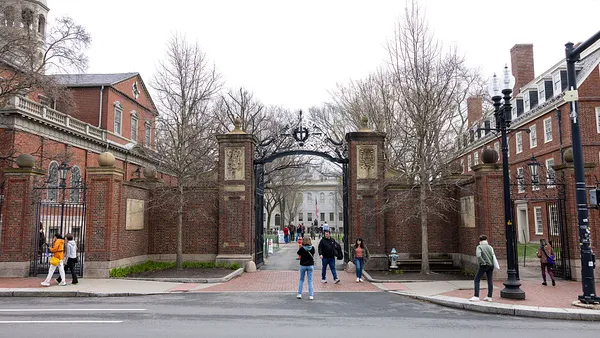Dive Brief:
- Public research universities talk about the need for their student body to represent the social and economic diversity of their states, but a new report from the Chicago-based policy research firm The Joyce Foundation suggests that those institutions disproportionately focus their recruiting efforts on wealthy out-of-state students.
- Analyzing the recruiting visits of 15 public research universities, the researchers found 12 made more out-of-state than in-state visits and seven had more than double the amount. Those out-of-state visits tend to be to affluent communities in major metro areas, shifting the demographic balance of the institution.
- Universities with lower levels of state support focused more on out-of-state recruiting than did institutions with stronger state support. Just three institutions, located in states with limits on nonresident enrollment, made more in-state than out-of-state visits.
Dive Insight:
The out-of-state visits "consistently exhibited racial bias," the researchers explain, attributing colleges' need to look beyond their borders to a "broken" higher ed funding system that "incentivizes universities to prioritize rich out-of-state students."
State funding to higher ed rose slightly across the board in fiscal year 2019, with more states (43) seeing increases than in the previous year (32), analysts explained in a Moody's Investors Service report earlier this year.
Yet the upturn follows a decade of contraction. In 2018, states spent an average of 16% less per student in 2018 than they did in 2008, while some states had drops in excess of 30%, according to data from the Center on Budget and Policy Priorities.
Public colleges vary in how much they depend on that funding, Moody's explains. Those in Alaska, Hawaii and Illinois rely on state funding for more than 40% of their revenue, whereas in New Hampshire, Pennsylvania and Vermont public institutions get less than 10% of revenue from the state.
As the Joyce Foundation report notes, low levels of state funding can push public colleges to recruit wealthy out-of-state students who require fewer or no subsidies, as well as some wealthy in-state students. The report's authors list the University of Alabama and the University of South Carolina as examples. "Universities make up for state budget cuts by prioritizing affluent students," they explain, calling on state policymakers to "reinvest in public higher education" by increasing state appropriations and need-based grant aid.
States are making moves in that direction, with some budgets under discussion tying additional funding to tuition freezes at public colleges. And the topic of affordability has come up in several governors' annual addresses, though that discussion tends to focus on increasing financial aid.
The researchers make a more pointed call to universities to shift their recruiting practices and "put their money where their mouth is, rather than putting their money where the money is" when it comes to increasing access for underrepresented students.
The University of Virginia — a public research institution in a state that gets between 15% and 20% of its higher ed revenue from public dollars, according to Moody's — last fall announced it would waive tuition for in-state students whose families earn less than $80,000 annually and room and board costs for those with annual incomes of less than $30,000.
And at the University of Illinois at Urbana-Champaign, students with family incomes at or below the state median may be eligible for free tuition and fees starting in the fall.














